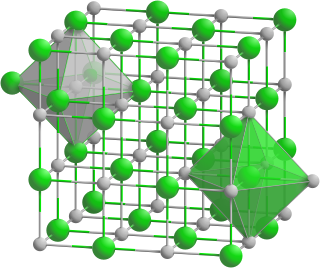
Holmium is a chemical element; it has symbol Ho and atomic number 67. It is a rare-earth element and the eleventh member of the lanthanide series. It is a relatively soft, silvery, fairly corrosion-resistant and malleable metal. Like many other lanthanides, holmium is too reactive to be found in native form, as pure holmium slowly forms a yellowish oxide coating when exposed to air. When isolated, holmium is relatively stable in dry air at room temperature. However, it reacts with water and corrodes readily, and also burns in air when heated.

Holmium(III) oxide, or holmium oxide is a chemical compound of the rare-earth element holmium and oxygen with the formula Ho2O3. Together with dysprosium(III) oxide (Dy2O3), holmium oxide is one of the most powerfully paramagnetic substances known. The oxide, also called holmia, occurs as a component of the related erbium oxide mineral called erbia. Typically, the oxides of the trivalent lanthanides coexist in nature, and separation of these components requires specialized methods. Holmium oxide is used in making specialty colored glasses. Glass containing holmium oxide and holmium oxide solutions have a series of sharp optical absorption peaks in the visible spectral range. They are therefore traditionally used as a convenient calibration standard for optical spectrophotometers.

Bismuth is a chemical element; it has symbol Bi and atomic number 83. It is a post-transition metal and one of the pnictogens, with chemical properties resembling its lighter group 15 siblings arsenic and antimony. Elemental bismuth occurs naturally, and its sulfide and oxide forms are important commercial ores. The free element is 86% as dense as lead. It is a brittle metal with a silvery-white color when freshly produced. Surface oxidation generally gives samples of the metal a somewhat rosy cast. Further oxidation under heat can give bismuth a vividly iridescent appearance due to thin-film interference. Bismuth is both the most diamagnetic element and one of the least thermally conductive metals known.
Oxybismuthides or bismuthide oxides are chemical compounds formally containing the group BiO, with one bismuth and one oxygen atom. The bismuth and oxygen are not bound together as in bismuthates, instead they make a separate presence bound to the cations (metals), and could be considered as a mixed bismuthide-oxide compound. So a compound with OmBin requires cations to balance a negative charge of 2m+3n. The cations will have charges of +2 or +3. The trications are often rare earth elements or actinides. They are in the category of oxypnictide compounds.
Lithium phosphide is an inorganic compound of lithium and phosphorus with the chemical formula Li3P. This dark colored compound is formally the lithium salt of phosphine, consisting of lithium cations Li+ and phosphide anions P3−. It is hazardous to handle because of its high reactivity toward air.
Praseodymium monophosphide is an inorganic compound of praseodymium and phosphorus with the chemical formula PrP. The compound forms crystals.
Thulium phosphide is an inorganic compound of thulium and phosphorus with the chemical formula TmP.
Holmium phosphide is a binary inorganic compound of holmium and phosphorus with the chemical formula HoP. The compound forms dark crystals and does not dissolve in water.
Samarium(III) arsenide is a binary inorganic compound of samarium and arsenic with the chemical formula SmAs.

Holmium acetate is the acetate salt of holmium, with a chemical formula of Ho(CH3COO)3 as well as at least one hydrate.

Neodymium bismuthide or Bismuth-Neodymium is a binary inorganic compound of neodymium and bismuth with the formula NdBi. It forms crystals.

Holmium(III) iodide is an iodide of holmium, with the chemical formula of HoI3. It is used as a component of metal halide lamps.
Erbium compounds are compounds containing the element erbium (Er). These compounds are usually dominated by erbium in the +3 oxidation state, although the +2, +1 and 0 oxidation states have also been reported.

Bismuth forms mainly trivalent and a few pentavalent compounds. Many of its chemical properties are similar to those of arsenic and antimony, although much less toxic.

Praseodymium bismuthide is a binary inorganic compound of praseodymium and bismuth with the chemical formula of PrBi. It forms crystals.
Holmium nitride is a binary inorganic compound of holmium and nitrogen with the chemical formula HoN.

Holmium arsenide is a binary inorganic compound of holmium and arsenide with the chemical formula HoAs.

Holmium antimonide is a binary inorganic compound of holmium and antimony with the chemical formula HoSb.

Dysprosium bismuthide is a binary inorganic compound of dysprosium and bismuth with the chemical formula DyBi.

Holmium monosulfide is a binary inorganic compound of holmium and sulfur with the chemical formula HoS.









